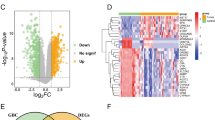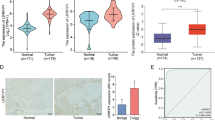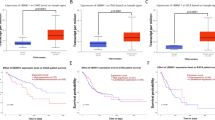Abstract
LncRNA-ROR has been reported to be involved in many kinds of human cancers. However, whether LncRNA-ROR is involved in gallbladder cancer progression remains largely unknown. The objective of this study is to investigate the role of LncRNA-ROR in gallbladder cancer. We found that LncRNA-ROR expression level was upregulated in gallbladder cancer tissues (P < 0.05) and was significantly associated with tumor sizes (P < 0.05) and lymph node metastasis (P < 0.05). High expression of LncRNA-ROR was significantly associated with poor prognosis in gallbladder cancer patients (P < 0.05). Moreover, knockdown of LncRNA-ROR inhibited cell proliferation, migration, and invasion. The epithelial-mesenchymal transition (EMT) phenotype induced by TGF-β1 was reversed after LncRNA-ROR knocking down in SGC-996 and Noz cells. LncRNA-ROR plays an important role in the development of gallbladder cancer and mediates the EMT in gallbladder cancer. LncRNA-ROR might act as a marker of prognosis and therapeutic target for gallbladder cancer.







Similar content being viewed by others
Reference
Kanthan R, Senger JL, Ahmed S, Kanthan SC. Gallbladder cancer in the 21st century. J Oncol. 2015;2015:967472.
Goetze TO. Gallbladder carcinoma: prognostic factors and therapeutic options. World J Gastroenterol. 2015;21(43):12211–7.
Aloia TA, Jarufe N, Javle M, Maithel SK, Roa JC, Adsay V, et al. Gallbladder cancer: expert consensus statement. HPB (Oxford). 2015;17(8):681–90.
Liz J, Esteller M. Lncrnas and micrornas with a role in cancer development. Biochim Biophys Acta. 2016;1859(1):169–76.
Managadze D, Lobkovsky AE, Wolf YI, Shabalina SA, Rogozin IB, Koonin EV. The vast, conserved mammalian lincrnome. PLoS Comput Biol. 2013;9(2):e1002917.
Ma MZ, Li CX, Zhang Y, Weng MZ, Zhang MD, YY Qin, et al. Long non-coding RNA HOTAIR, a c-myc activated driver of malignancy, negatively regulates miRNA-130a in gallbladder cancer. Mol Cancer. 2014;13:156.
Ma MZ, Chu BF, Zhang Y, Weng MZ, Qin YY, Gong W, et al. Long non-coding RNA CCAT1 promotes gallbladder cancer development via negative modulation of miRNA-218-5p. Cell Death Dis. 2015;6:e1583.
Wu XS, Wang XA, Wu WG, Hu YP, Li ML, Ding Q, et al. Malat1 promotes the proliferation and metastasis of gallbladder cancer cells by activating the ERK/MAPK pathway. Cancer Biol Ther. 2014;15(6):806–14.
Wang Y, Xu Z, Jiang J, Xu C, Kang J, Xiao L, et al. Endogenous miRNA sponge lincRNA-RoR regulates oct4, Nanog, and sox2 in human embryonic stem cell self-renewal. Dev Cell. 2013;25(1):69–80.
Loewer S, Cabili MN, Guttman M, Loh YH, Thomas K, Park IH, et al. Large intergenic non-coding rna-ror modulates reprogramming of human induced pluripotent stem cells. Nat Genet. 2010;42(12):1113–7.
Takahashi K, Yan IK, Kogure T, Haga H, Patel T. Extracellular vesicle-mediated transfer of long noncoding RNA RoR modulates chemosensitivity in human hepatocellular cancer. FEBS Open Bio.2014;4:458–67.
Hou P, Zhao Y, Li Z, Yao R, Ma M, Gao Y, et al. LincRNA-RoR induces epithelial-to-mesenchymal transition and contributes to breast cancer tumorigenesis and metastasis. Cell Death Dis. 2014;5:e1287.
Mitra A, Mishra L, Li S. Emt, ctcs and cscs in tumor relapse and drugresistance. Oncotarget. 2015;6(13):10697–711.
Brivio S, Cadamuro M, Fabris L, Strazzabosco M. Epithelial-to-mesenchymal transition and cancer invasiveness: what can we learn from cholangiocarcinoma? J Clin Med. 2015;4(12):2028–41.
Creighton CJ, Gibbons D, Kurie JM. The role of epithelial-mesenchymal transition programming in invasion and metastasis: a clinical perspective. Cancer Manag Res. 2013;5:187–95.
Peinado H, Olmeda D, Cano A. Snail, zeb and bhlh factors in tumour progression: an alliance against the epithelial phenotype? Nat Rev Cancer. 2007;7(6):415–28.
Guil S, Esteller M. RNA-RNA interactions in gene regulation: the coding and noncoding players. Trends Biochem Sci. 2015;40(5):248–56.
Takahashi K, Yan Ik, Haga H, Patel T. Modulation of hypoxia-signaling pathways by extracellular lincror. J Cell Sci. 2014;127:1585–94.
Eades G, Wolfson B, Zhang Y, Li Q, Yao Y, Zhou Q. LincRNA-RoR and mir-145 regulate invasion in triple-negative breast cancer via targeting arf6. Mol Cancer Res. 2015;13(2):330–8.
Gao S, Wang P, Hua Y, Xi H, Meng Z, Liu T, et al. Ror functions as a cerna to regulate nanog expression by sponging mir-145 and predicts poor prognosis in pancreatic cancer. Oncotarget. 2016;7(2):1608–18.
Feng S, Yao J, Chen Y, Geng P, Zhang H, Ma X, etal. Expression and functional role of reprogrammingrelated long noncoding RNA (lincRNA-RoR) in glioma. J Mol Neurosci. 2015;56(3):623–30.
Wang SH, Wu XC, Zhang MD, Weng MZ, Zhou D, Quan ZW. Long noncoding RNA h19 contributes to gallbladder cancer cell proliferation by modulated mir-194-5p targeting akt2. Tumour Biol. 2016. doi:10.1007/s13277-016-4852-1.
Acknowledgments
This work was supported by the National Natural Science Foundation of China (Grant number 81272747 and 81572297) and Doctorial innovation funds of Shanghai Jiao Tong University School of Medicine. We thank Dr. QIU LEI, helped us with language editing.
Author information
Authors and Affiliations
Corresponding author
Ethics declarations
All procedures performed in studies involving human participants were in accordance with the ethical standards of the institutional and/or national research committee and with the 1964 Helsinki declaration and its later amendments or comparable ethical standards. This study was approved by the Human Ethics Committee of Xinhua Hospital at Shanghai Jiao tong University (Shanghai, China).
Conflicts of interest
None.
Rights and permissions
About this article
Cite this article
Wang, SH., Zhang, MD., Wu, XC. et al. Overexpression of LncRNA-ROR predicts a poor outcome in gallbladder cancer patients and promotes the tumor cells proliferation, migration, and invasion. Tumor Biol. 37, 12867–12875 (2016). https://doi.org/10.1007/s13277-016-5210-z
Received:
Accepted:
Published:
Issue Date:
DOI: https://doi.org/10.1007/s13277-016-5210-z




